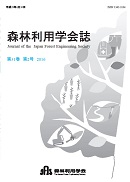All issues

Volume 30 (2015)
- Issue 4 Pages 145-
- Issue 3 Pages 103-
- Issue 2 Pages 71-
- Issue 1 Pages 3-
Predecessor
Volume 30, Issue 2
Displaying 1-2 of 2 articles from this issue
- |<
- <
- 1
- >
- >|
Article
-
Sayaka SAKAI, Humiko TERADA, Ichiro WATANABE, Shozo SASAKIArticle type: Article
2015Volume 30Issue 2 Pages 71-78
Published: April 30, 2015
Released on J-STAGE: April 03, 2017
JOURNAL OPEN ACCESSA more accurate estimation of the amount of available woody biomass with an increase in demand depends on the introduction of the Feed-in Tariff Scheme for Renewable Energy. We calculated the amount of logging residues for 1 year in all the 179 towns in Hokkaido using the data on operational systems and the size of the minimum top end for pulpwood, i.e., logging residue ratios. We used the CIS system to search for sub- compartments carrying out logging residues effectively. We considered the local forest plan of thinning and final cutting in each jurisdiction: national forest, Hokkaido Prefectural forest, and private forest. Our results showed that with water contents of 30% DB, approximately 360,000-tons of forest biomass are efficiently collected in 1 year through whole-tree harvesting and approximately 200,000 tons are collected through tree-length harvesting. There are new woody biomass power stations under consideration in Hokkaido, and to satisfy their demand for unusual woody biomass with only logging residues, the biomass would have to be collected from outside the 100-km area from their building sites.View full abstractDownload PDF (1349K)
Research and technical report
-
Hirofumi TAKAHASHI, Hideo SAKAI, Hisao USUDA, Tomohiro WATADA, Kuniaki ...Article type: Article
2015Volume 30Issue 2 Pages 79-84
Published: April 30, 2015
Released on J-STAGE: April 03, 2017
JOURNAL OPEN ACCESSDownload PDF (9471K)
- |<
- <
- 1
- >
- >|